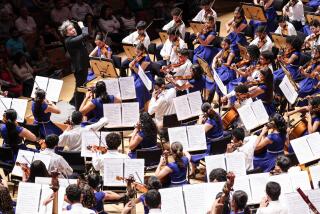Music Reviews : Cincinnati Symphony at Ambassador
Although formed in 1895, the Cincinnati Symphony has only recently gotten around to making its first West Coast tour, leaving mixed impressions in its wake.
The orchestra sounded rich and focused in a program of works by Walton, Liszt and Tchaikovsky on Sunday at the 1,200-seat Ambassador Auditorium in Pasadena. It had sounded raucous in the tour-opening concert that included Brucknerâs Ninth Symphony on Thursday at the 3,000-seat Orange County Performing Arts Center.
Still, common frustrations remained, and they centered on the efficient, visionless conducting of music director Jesus Lopez-Cobos.
That lack mattered less in the sardonic vignettes in the two suites from Waltonâs âFacadeâ than it did in Lisztâs âTasso: lamento et trionfo,â but it was critical in Tchaikovskyâs Symphony No. 4.
Except for the sometimes clotted and dense textures arising from Waltonâs orchestrating a work he first wrote for chamber ensemble, Lopez-Cobos led a clear, precise and suave account of this music, respectful of its cockeyed buoyancy, elegance and wit. It was the only work on the program that he chose to conduct from a score.
In addressing Lisztâs seldom-heard symphonic poem after Byron, Lopez-Cobos may have failed to convey ideal Byronic sweep and outsized passion or persuade that the work cohered after all. But he offered a clean, respectable account, highlighted by some forceful ensemble work as well as delicate string tremolos.
Tchaikovskyâs Fourth Symphony emerged strong, disciplined and forceful, but without, however, the passionate conflict that makes sense of it all.
By applying steady dynamic evenness in phrasing and rushing musicians off important notes, Lopez-Cobos diminished Tchaikovskyâs musical shapes and aims and eliminated a sense of the composerâs personal voice.
Many conductors besides Lopez-Cobos regularize the melancholic folklike tune that opens the second movement, but virtually no one else takes the Slavic motive in the finale as one quick diminuendo, utterly destroying its character.
To be sure, the conductor ended the work with such breathless precision and velocity that many in the audience felt impelled to rise to their feet and applaud. Nonetheless, it remained hollow noise and a soulless account of the music.
More to Read
The biggest entertainment stories
Get our big stories about Hollywood, film, television, music, arts, culture and more right in your inbox as soon as they publish.
You may occasionally receive promotional content from the Los Angeles Times.










